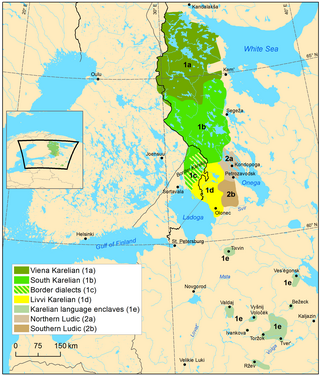
The Republic of Karelia, Karjala or Karelia, is a republic of Russia situated in the northwest of the country. The republic is a part of the Northwestern Federal District, and covers an area of 172,400 square kilometres, with a population of 533,121 residents. Its capital is Petrozavodsk.

Karelian is a Finnic language spoken mainly in the Russian Republic of Karelia. Linguistically, Karelian is closely related to the Finnish dialects spoken in eastern Finland, and some Finnish linguists have even classified Karelian as a dialect of Finnish, though in the modern day it is widely considered a separate language. Karelian is not to be confused with the Southeastern dialects of Finnish, sometimes referred to as karjalaismurteet in Finland. In the Russian 2020–2021 census, around 9,000 people spoke Karelian natively, but around 14,000 said to be able to speak the language.
The Aunus expedition was an attempt by Finnish volunteers to occupy parts of East Karelia in 1919, during the Russian Civil War. Aunus is the Finnish name for Olonets Karelia. This expedition was one of many Finnic "kinship wars" (heimosodat) fought against forces of Soviet Russia after the Russian Revolution of 1917 and during the Russian Civil War.

Karelia is an area in Northern Europe of historical significance for Russia, Finland, and Sweden. It is currently divided between northwestern Russia and Finland.

Olonets Karelia is a historical and cultural region and the southern portion of East Karelia, which is part of Russia. Olonets Karelia is located between the other historical regions of Ladoga Karelia, to its west, White Karelia, to its north, the River Svir, to its south and Lake Onega on its eastern side. Olonets Karelia is home to its own dialect of the Karelian language, which is known as Livvi Karelian or sometimes as 'Olonets Karelian'.

Olonetsky District is an administrative district (raion), one of the fifteen in the Republic of Karelia, Russia.

Greater Finland, was an irredentist and nationalist idea that was a subset of Pan-Finnicism which emphasized the territorial expansion of Finland. The most common concept of Greater Finland saw the country as defined by natural borders encompassing the territories inhabited by Finns and Karelians, ranging from the White Sea to Lake Onega and along the Svir River and Neva River—or, more modestly, the Sestra River—to the Gulf of Finland. Some proponents also included the Torne Valley, Ingria, and Estonia.

The flag of the Republic of Karelia is the official state symbol of the Republic of Karelia. Adopted by the Supreme Council of the Republic of Karelia on February 16, 1993. The flag was designed by Alexander Ivanovich Kinnear.

The Karelian Autonomous Soviet Socialist Republic, Karelian ASSR for short, sometimes referred to as Soviet Karelia or simply Karelia, was an autonomous republic of the Russian SFSR, Soviet Union, with the capital in Petrozavodsk.

Eero Haapalainen was a Finnish politician, trade unionist and journalist, who served as the commander-in-chief of the Red Guards from January to March 1918 during the Finnish Civil War.

The East Karelian Uprising and the Soviet–Finnish conflict 1921–1922 were an attempt by a group of East Karelian separatists to gain independence from the Russian Soviet Federative Socialist Republic. They were aided by a number of Finnish volunteers, starting from 6 November 1921. The conflict ended on 21 March 1922 with the Agreements between the governments of Soviet Russia and Finland about the measures of maintenance of the inviolability of the Soviet–Finnish border. The conflict is regarded in Finland as one of the heimosodat – "Kinship Wars".

The Finnish invasion of East Karelia was a military campaign in 1941. It was part of the Continuation War. Finnish troops occupied East Karelia and held it until 1944. For over a month after the outbreak of the Continuation War, the Karelian Army reinforced and prepared to resume its earlier offensive while waiting for the recapture of the Karelian Isthmus. The Soviets had prepared fortifications and brought troops to the front. When encirclements on the western shore of Lake Ladoga were resolved, the Finnish 7th Division was transferred to the junction of VI and VII Corps.
Pro-independence movements in the Russian Civil War within the territory of the former Russian Empire sought the creation of independent and non-Bolshevik nation states after the October Revolution, therefore being in direct conflict with the Russian Soviet Republic which sought to conquer them. They were often supported politically or militarily by the Entente Powers. Some of them co-operated with the Russian White movement, but others were in conflict with it. Many pro-independence movements emerged after the dissolution of the Russian Empire and fought in the Russian Civil War.
The Karelian language is spoken in Russia, mostly in the Karelian Republic and in a small region just north of Tver, though most residents there were expelled in 1939. Karelian has seen numerous proposed and adopted alphabets over the centuries, both Latin and Cyrillic. In 2007, the current standardized Karelian alphabet was introduced and is used to write all varieties of Karelian, including Tver Karelian which adopted it in 2017.

The Republic of Uhtua, also Provisional Government of Karelia, officially called the Republic of East Karelia was an unrecognized state that existed from 1919 to 1920, formed out of five volosts in the Kemsky Uyezd of the Arkhangelsk Governorate.
Lyudmila Fyodorovna Markianova is a Karelian linguist and a professor emerita. She has been called "karjalan kielen muamo", i.e. 'mother of the Karelian language'.

The Karelian United Government was a short-lived state that existed from 1920 to 1923, as a merger of the Republic of Uhtua and the Olonets Government of Southern Karelia.

Kestenga is a rural village in the Loukhsky District of the Republic of Karelia in Russia on the northern shore of Lake Topozero.
The Finnish Operation of the NKVD was a mass arrest, execution and deportations of persons of Finnish origin in the Soviet Union by the NKVD during the period of Great Purge (1937–1938). It was a part of the larger mass operations of the NKVD which targeted many minority nationalities in the Soviet Union. Different estimations range from 8,000 to 25,000 of Finns killed or disappearing during the repression.

Viktor Nikolayevich Stepanov is a Russian politician who was the prime minister of the Republic of Karelia in 1994–98.















